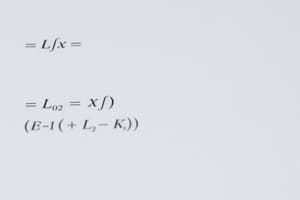Podcast
Questions and Answers
What does the method of related rates involve?
What does the method of related rates involve?
- Finding the slope of a tangent line at a specific point
- Calculating the limit of a function as it approaches an indeterminate form
- Finding the rate of change of one quantity in terms of another related quantity (correct)
- Determining the area under a curve
Which of the following correctly defines a series?
Which of the following correctly defines a series?
- The sum of the terms of a sequence (correct)
- The limit of a sequence as it approaches infinity
- An equation that describes the relationship between two variables
- A sequence of ordered numbers that follows a specific pattern
Which theorem ensures the existence of a point where the instantaneous rate of change equals the average rate of change?
Which theorem ensures the existence of a point where the instantaneous rate of change equals the average rate of change?
- L'Hôpital's Rule
- Fundamental Theorem of Calculus
- Rolle's Theorem
- Mean Value Theorem (correct)
In what field is L'Hôpital's Rule primarily used?
In what field is L'Hôpital's Rule primarily used?
What is the significance of the Fundamental Theorem of Calculus?
What is the significance of the Fundamental Theorem of Calculus?
What is a necessary condition for a limit to exist at a certain value?
What is a necessary condition for a limit to exist at a certain value?
Which differentiation rule would you use to find the derivative of the function f(x) = x^3 + 5x?
Which differentiation rule would you use to find the derivative of the function f(x) = x^3 + 5x?
What does the derivative of a function represent?
What does the derivative of a function represent?
Which of the following is a technique used for solving integrals?
Which of the following is a technique used for solving integrals?
Which application does not typically involve the use of derivatives?
Which application does not typically involve the use of derivatives?
In the context of limits, what does the epsilon-delta definition help to formalize?
In the context of limits, what does the epsilon-delta definition help to formalize?
What is an application of integrals in physics?
What is an application of integrals in physics?
Which of the following rules is used to differentiate the function f(x) = k * g(x), where k is a constant?
Which of the following rules is used to differentiate the function f(x) = k * g(x), where k is a constant?
Flashcards
Related Rates
Related Rates
Finding the rate of change of one quantity if another related quantity's rate of change is known.
Sequences
Sequences
Ordered lists of numbers.
Series
Series
Sums of sequences.
L'Hôpital's Rule
L'Hôpital's Rule
Signup and view all the flashcards
Mean Value Theorem
Mean Value Theorem
Signup and view all the flashcards
Derivative
Derivative
Signup and view all the flashcards
Limit
Limit
Signup and view all the flashcards
Power Rule
Power Rule
Signup and view all the flashcards
Definite Integral
Definite Integral
Signup and view all the flashcards
Implicit Differentiation
Implicit Differentiation
Signup and view all the flashcards
Continuity
Continuity
Signup and view all the flashcards
Substitution
Substitution
Signup and view all the flashcards
Integration
Integration
Signup and view all the flashcards
Study Notes
Limits and Continuity
- Limits describe the behavior of a function as its input approaches a particular value.
- A limit exists if the function approaches the same value from both sides as the input approaches a certain value.
- Limits are crucial for defining continuity and calculating derivatives.
- Formal definitions of limits exist, involving epsilon-delta proofs.
- Applications of limits include finding asymptotes and instantaneous rates of change.
Derivatives
- Derivatives represent the instantaneous rate of change of a function.
- They are calculated using limit definitions or differentiation rules.
- Some basic differentiation rules include the power rule, sum/difference rule, constant multiple rule, product rule, quotient rule, and chain rule.
- Derivatives help to find maximum and minimum values, sketch graphs, and solve optimization problems.
- Applications of derivatives include velocity, acceleration, marginal cost, and marginal revenue.
Differentiation Rules
- Power Rule: The derivative of xn is nxn-1.
- Sum/Difference Rule: The derivative of (f(x) ± g(x)) is f'(x) ± g'(x).
- Constant Multiple Rule: The derivative of kf(x) is kf'(x).
- Product Rule: The derivative of (f(x)*g(x)) is f'(x)g(x) + f(x)g'(x).
- Quotient Rule: The derivative of (f(x)/g(x)) is (g(x)f'(x) - f(x)g'(x))/(g(x))2.
- Chain Rule: The derivative of (f(g(x))) is f'(g(x))*g'(x).
Integrals
- Integrals are used to find the area under a curve.
- There are two main types:
- Definite integrals: Calculate the area between a curve and the x-axis over a specific interval.
- Indefinite integrals: Find the general antiderivative of a function.
Integration Techniques
- Basic integration rules: Similar to differentiation rules, but reversed.
- Substitution: Using a substitution to simplify an integral.
- Integration by parts: Using the product rule in reverse to solve integrals.
- Trigonometric substitutions: Dealing with integrals involving trigonometric functions.
- Partial fraction decomposition: Breaking down complex rational functions into simpler components.
Applications of Integrals
- Calculating areas and volumes.
- Finding displacement and velocity.
- Solving optimization problems (maximum profit).
- Calculating work.
- Probability and statistics.
Implicit Differentiation
- Differentiating implicitly helps find the derivative of a relation or equation that isn't a function.
- This method is important for relations that aren't expressible in the form y = f(x).
Related Rates
- Related rates problems involve finding the rate of change of one quantity in terms of the rate of change of another related quantity.
- These problems often involve implicit differentiation.
Sequences and Series
- Sequences: Ordered lists of numbers.
- Series: Sums of sequences.
- Types of sequences/series: Arithmetic, geometric, etc.
- Convergence of series: Determining if a series approaches a finite value or diverges.
Applications of Calculus
- Physics: Finding velocity, acceleration, and position.
- Engineering: Optimizing design, calculating work, and modelling systems.
- Economics: Calculating marginal costs and maximizing profits.
- Computer graphics: Generating smooth curves and surfaces.
Additional Concepts
- L'Hôpital's Rule: Used to evaluate limits that involve indeterminate forms (e.g., 0/0, ∞/∞).
- Mean Value Theorem: Guarantees the existence of a point where the instantaneous rate of change equals the average rate of change.
- Fundamental Theorem of Calculus: Establishes the relationship between differentiation and integration.
- Applications of the Fundamental Theorem of Calculus: Finding areas under curves.
Studying That Suits You
Use AI to generate personalized quizzes and flashcards to suit your learning preferences.




